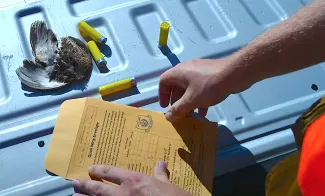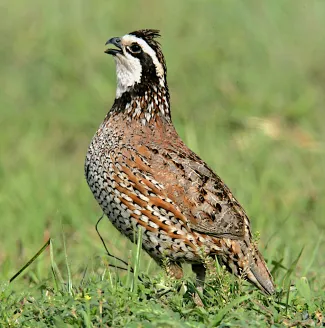
By Tell Judkins, Upland Game Biologist
This year’s August roadside survey results suggest northern bobwhite numbers have declined slightly from last year on average across all of Oklahoma. But when broken into regions, the north-central and northeastern parts of the state showed better quail numbers compared to August 2021.
The Oklahoma Department of Wildlife Conservation (ODWC) has conducted annual roadside surveys in August and October since 1990 to provide an index of annual quail population fluctuations. The number of quail observed is reported to provide an index of quail abundance and indicates reproductive success.
ODWC employees surveyed 81 routes in 75 of Oklahoma’s 77counties. Oklahoma and Tulsa counties are not surveyed.
The state is divided into geographic regions and ecoregions to compare the index year to year. By looking at these divisions separately, biologists get a more precise view of on-the-ground conditions in each county. These divisions also can give hunters a better idea of conditions in the county they intend to hunt.
The 2022 August roadside quail survey shows the statewide quail index down slightly from 2021, from 1.56 to 1.53 quail per route (Table 1). This is 70.02 percent below the 33-year average, and 50.47 percent below the 10-year average of 3.089 (Figure 1).
Several theories exist as to what has caused this decline, primarily habitat loss and unfavorable weather.
Half of the observed birds were fully grown, 31.5 percent were three-fourths grown, 18.5 percent were half grown, and none were one-fourth grown. This age structure could indicate successful early broods, which might have played a part in low August survey numbers as older juvenile birds may be less likely to stay in brood groups while traveling.
Additionally, ODWC biologists have received several anecdotal reports of broods of multiple age-class young seen during the survey period in areas not along survey routes.
Results from the northeast and north-central regions of the state improved from the 2021 survey. Observations in all geographic regions of the state, other than the north-central region, are currently well below their historic 33-year average.
When evaluated across ecoregions, quail observations were a mixed bag, with four regions showing increases and five regions showing no change or decreases. (Table 2).
Winter 2021-22 again brought several cold fronts and storms that held potential for negative impacts to quail that were likely more severe in areas of marginal habitat quality. Spring and summer brought flash drought across much of the state. Rainfall during spring and summer has been sporadic, coming at times in monsoon-type storms rather than more usual systemic rains. As of Sept. 1, drought was statewide, with nearly 50 percent of the state in extreme or exceptional drought. Over the past 180 days, most of the state has received less-than-normal rainfall.
Biologists can get a better look at bird numbers by analyzing surveys on an ecoregion basis.
No scaled quail were observed during the August 2022 survey. Only a few routes in Oklahoma offer an opportunity to observe scaled quail. This is not a prediction of scaled quail abundance, but strictly an observation. ODWC biologists have received several reports of scaled quail broods in Oklahoma’s Panhandle.
In 33 years of conducting these quail surveys, the August survey’s findings have not been the most reliable when it comes to forecasting the hunting season. The annual October roadside surveys will provide a better indication of what the upcoming quail season might have in store.
For a complete look at findings from the August 2022 quail roadside survey, go to https://www.wildlifedepartment.com/sites/default/files/2022-09/2022AugustRoadsideReport.pdf.
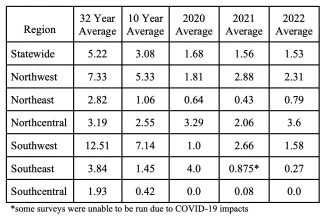
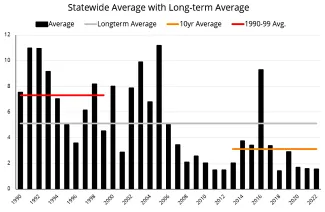
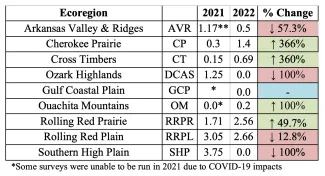
By Tell Judkins, Upland Game Biologist
This year’s August roadside survey results suggest northern bobwhite numbers have declined slightly from last year on average across all of Oklahoma. But when broken into regions, the north-central and northeastern parts of the state showed better quail numbers compared to August 2021.
The Oklahoma Department of Wildlife Conservation (ODWC) has conducted annual roadside surveys in August and October since 1990 to provide an index of annual quail population fluctuations. The number of quail observed is reported to provide an index of quail abundance and indicates reproductive success.
ODWC employees surveyed 81 routes in 75 of Oklahoma’s 77counties. Oklahoma and Tulsa counties are not surveyed.
The state is divided into geographic regions and ecoregions to compare the index year to year. By looking at these divisions separately, biologists get a more precise view of on-the-ground conditions in each county. These divisions also can give hunters a better idea of conditions in the county they intend to hunt.
The 2022 August roadside quail survey shows the statewide quail index down slightly from 2021, from 1.56 to 1.53 quail per route (Table 1). This is 70.02 percent below the 33-year average, and 50.47 percent below the 10-year average of 3.089 (Figure 1).
Several theories exist as to what has caused this decline, primarily habitat loss and unfavorable weather.
Half of the observed birds were fully grown, 31.5 percent were three-fourths grown, 18.5 percent were half grown, and none were one-fourth grown. This age structure could indicate successful early broods, which might have played a part in low August survey numbers as older juvenile birds may be less likely to stay in brood groups while traveling.
Additionally, ODWC biologists have received several anecdotal reports of broods of multiple age-class young seen during the survey period in areas not along survey routes.
Results from the northeast and north-central regions of the state improved from the 2021 survey. Observations in all geographic regions of the state, other than the north-central region, are currently well below their historic 33-year average.
When evaluated across ecoregions, quail observations were a mixed bag, with four regions showing increases and five regions showing no change or decreases. (Table 2).
Winter 2021-22 again brought several cold fronts and storms that held potential for negative impacts to quail that were likely more severe in areas of marginal habitat quality. Spring and summer brought flash drought across much of the state. Rainfall during spring and summer has been sporadic, coming at times in monsoon-type storms rather than more usual systemic rains. As of Sept. 1, drought was statewide, with nearly 50 percent of the state in extreme or exceptional drought. Over the past 180 days, most of the state has received less-than-normal rainfall.
Biologists can get a better look at bird numbers by analyzing surveys on an ecoregion basis.
No scaled quail were observed during the August 2022 survey. Only a few routes in Oklahoma offer an opportunity to observe scaled quail. This is not a prediction of scaled quail abundance, but strictly an observation. ODWC biologists have received several reports of scaled quail broods in Oklahoma’s Panhandle.
In 33 years of conducting these quail surveys, the August survey’s findings have not been the most reliable when it comes to forecasting the hunting season. The annual October roadside surveys will provide a better indication of what the upcoming quail season might have in store.
For a complete look at findings from the August 2022 quail roadside survey, go to https://www.wildlifedepartment.com/sites/default/files/2022-09/2022AugustRoadsideReport.pdf.



DONATE YOUR WINGS: During quail hunting season, wing collection boxes are placed near entrances at several wildlife management areas: Beaver River, Optima, Packsaddle, Cooper, Kaw, Drummond Flats, Canton, Fort Supply, Cross Timbers, and Pushmataha.
For research purposes, hunters are asked to donate a wing from each quail they harvest using the envelopes provided. Wing research can help determine the status of quail populations at those WMAs and can offer clues about how next year’s season might pan out. Learn more by watching a segment of the Outdoor Oklahoma TV show online at https://youtu.be/MsK0Lqb3Br4?t=522.
